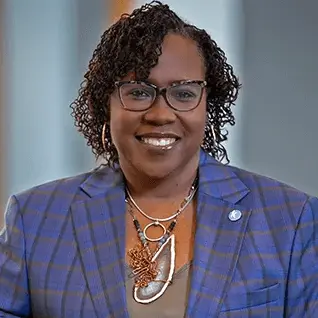What nonprofits want: Support for capacity building and collective impact
Learn why the Ewing Marion Kauffman Foundation introduced two new types of support: capacity-building and collective impact funding to help nonprofits increase their sustainability and engage in systems change work.

During my first year as CEO of the Ewing Marion Kauffman Foundation, our biggest priority was listening. Since late 2023, we’ve been talking with community members about how, together, we could make Kansas City a national model for equitable economic mobility.
Two significant gaps became evident that we saw as two sides of the same coin:
- Nonprofits don’t often have space to truly think about their strengths and sustainability.
- Nonprofits don’t often have the opportunity to “dream big.”
To address those gaps, in August 2024, as part of our refreshed grantmaking philosophy, we introduced two new funding types: Capacity Building and Collective Impact. Our aim is to provide organizations the opportunity to evaluate their capacity and sustainability, while also encouraging them to look out across the sector to build coalitions to create systems change.
Is this how we build a model for significant, long-lasting systems change? Maybe.
We don’t know the answer yet. What we do know is that this work is complex. In our role as catalyst and convener, we will continue our community conversations, and the lessons we learn along the way will help strengthen our work.
Capacity building: Set aside the familiar project-funding mindset
We strove to develop what our community asked for: support that sets aside the project-funding mindset to focus on what nonprofits need to leverage their strengths and create organizational sustainability. Capacity Building funding provides much-needed support for what many organizations had been doing without: resources to strengthen leadership and boards, professional development, technology, evaluation, strategic planning, communications, etc.
We held live webinars and community “office hours” where applicants could ask questions. We received more than 150 applications, which suggests the breadth of capacity-building needs across the sector. In November, we announced the first cohort of 55 grant recipients, organizations working to advance college access and completion, workforce and career development, and entrepreneurship.
Our hope is that funding to close capacity gaps in nonprofits aligned with our priorities will strengthen their eligibility for larger Project and Collective Impact funding. This, in turn, will create a pipeline of impactful, innovative organizations working in our priority areas toward equitable economic mobility.
We also believe this funding can accelerate learning in the sector by fostering intentional conversations with peer funders in our region as well as connecting organizations that can help their peers meet capacity needs, so we’re working as a vibrant ecosystem.
Collective impact: Space to operationalize systems change
Changemakers who dare to “dream big” rarely do it without caveats: If only we had time; if only we had the funding, if only everyone could work together. Our Collective Impact funding supports coalitions of organizations in creating a systems change strategy to close economic mobility gaps.
The idea of “collective impact” challenged organizations to evaluate what and how they’re doing systems change work. It created space to think differently—if sometimes uncomfortably—about how they’re working on an issue area and how their coalitions are going to operationalize their collective efforts. It’s extremely complex work. Led by an intermediary organization, funded coalitions must work together under a collective impact model that includes backbone support, a common agenda, mutually reinforcing activities, shared measurement, and continuous communication.
That’s why, from its inception, Collective Impact has been a two-tier funding opportunity that awards planning funding separately from implementation funding. The planning period allows a coalition to really kick the tires and work out the kinks, to work closely with us and with others’ expertise. It also provides the time to delve into what constitutes an effective coalition.
The nine-month planning process asks organizations to go beyond casual partnerships to think about how to leverage the unique strengths and capacities of coalition members and figure out how to function as a collective entity toward systems change. What does project management look like among multiple organizations or communications that have both internal and external components?
While planning funding does not guarantee implementation funding, we believe the lessons learned will be extremely valuable to planning awardees. They will be stronger, more intentional, more thoughtful; they may have a clearer understanding of the scope of their proposal and how to achieve it. Coalitions may realize a shift in focus might lead to the most significant change.
This two-tier funding also enables us as grantmakers to identify what an effective intermediary organization looks like, define what collective impact really means, and advance clear and transparent grantmaking.
Building capacity and collective impact together
Our founder, Ewing Marion Kauffman, believed: “All the money in the world cannot solve problems unless we work together. And, if we work together, there is no problem in the world that can stop us.”
Is this how we build a national model for equitable economic mobility? Maybe.
What we do know is that building trust through community conversations and shared learning will be key and developing the capacity of organizations and coalitions of changemakers is essential for success. And while we’ll adjust and revise as we undertake this most difficult work, we have one constant: We know we build it together.
Photo credit: Ewing Marion Kauffman Foundation
About the authors
